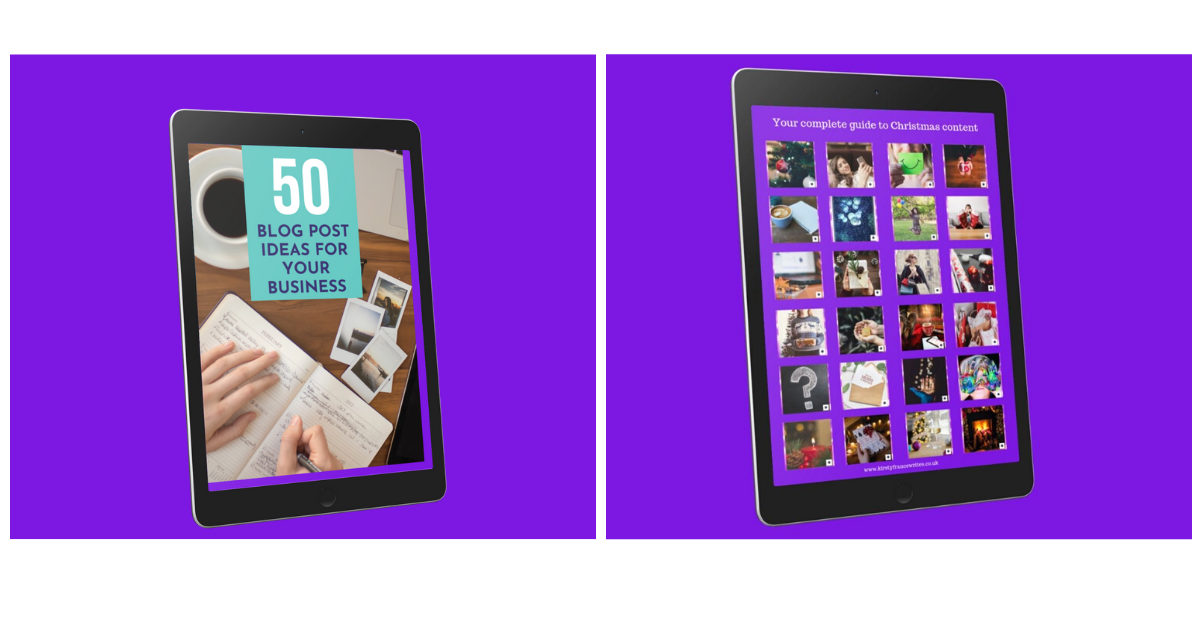
If you run a business that sells perfect Christmas gifts, this is probably peak season for you. I’ve already started my Christmas shopping and I’ve got a list of local businesses that I’ll be buying from in the coming month. I know that you’re already doing loads of marketing to show people what you have to offer. If you’re not already writing a blog it can be a great way to showcase your products and build your profile.
A Facebook or Instagram post can be amazing at getting an immediate response. I’ve already bought presents for two people based on a photo the seller posted on Facebook. However, one of the reasons for my quick decision was that I already knew the business. Building relationships is incredibly important when you have a small business. You might already be doing that at events or online and a blog can be a big part of that. A blog can be chatty and helpful which makes people more likely to trust you when you post about something you’re selling.
So without further ado here are my top 5 ideas for blogs that will help you to sell more Christmas gifts.
1. Your ultimate gift guide
This one does what it says on the tin – write a monster post with your best ideas for every family member and interest group that you could possibly sell to. It’s the kind of thing that people will save for reference. This could take you quite a long time depending on how many products you have, so you might prefer to break it down into…
2. Christmas gifts for…
You can write as many of these as you like and tailor them to your business. If you offer perfect gifts for women, children or a particular interest, break it down. You might write about choosing jewellery or your best gifts for kids who love dinosaurs. Your audience will find it really helpful and you can include pictures with product links to make it easy for them to buy.
3. How to buy for the awkward one
We’ve all got one – the person we struggle to buy for every year. What have you got that’s a bit out of the ordinary? This could also be a great opportunity to educate people about your products. For example, a gift buyer with a newly vegan relative might think of them as ‘awkward’ – you could be the one to offer a gift that will change their view.
4. What to buy for the person who has everything
Do you sell gifts for people who don’t want more stuff? Experience gifts or charity donations? You could also give ideas for interesting budget gifts for when you’re skint but need to buy for wealthier relatives. What do you sell for the person who doesn’t want to buy their mum more jewellery or yet another scarf?
5. Are you a Secret Santa?
The dreaded Secret Santa can be a real challenge. Your customers might be buying for someone they don’t know very well or have a tiny budget. Can you help them to come up with something interesting and avoid falling back on an Amazon voucher? (Yes, I’ve had this – the perils of being a temp who still got invited to the team Christmas lunch.)
If you’re planning your Christmas marketing (or your non-Christmas marketing) and need some more ideas, head to my shiny new online shop where you’ll find ’50 blog post ideas for your business’ and my guide to Christmas marketing which gives you ideas for social media posts from 1st December all the way to Christmas Eve.





 One of the many benefits of writing a blog (if you want to know the others read this) is that it helps your future customers get to know you. You can talk to them about the stuff they’re interested in like a human being rather than a corporate cardboard cut-out. A lot of people love the idea of buying from a small business but they’re wary of being ripped off. The end result is that they go and buy something from a reliable big name brand and not you. A blog helps you to overcome that by letting them see the person behind the business. Of course, the downside of this is that you have to put yourself front and centre. The idea of sharing your story is all very well but what if there are still parts of your life that you want to protect? The good news is that you can write a blog and still maintain your privacy. You just need to follow a few simple steps.
One of the many benefits of writing a blog (if you want to know the others read this) is that it helps your future customers get to know you. You can talk to them about the stuff they’re interested in like a human being rather than a corporate cardboard cut-out. A lot of people love the idea of buying from a small business but they’re wary of being ripped off. The end result is that they go and buy something from a reliable big name brand and not you. A blog helps you to overcome that by letting them see the person behind the business. Of course, the downside of this is that you have to put yourself front and centre. The idea of sharing your story is all very well but what if there are still parts of your life that you want to protect? The good news is that you can write a blog and still maintain your privacy. You just need to follow a few simple steps. I’m generally not a fan of stating the bleeding obvious. I don’t like it when people talk down to me so there’s no way I’m going to do it to anyone. The trouble is, sometimes it leads me to credit people with knowledge that they don’t already have. This is not a criticism. When you’re a small business owner there’s a massive amount of stuff to learn. Even if marketing is towards the top of your list of things to get to grips with, the benefits of writing a blog could still be a long way down. If that’s the case for you, here’s why a blog could do wonders for your business.
I’m generally not a fan of stating the bleeding obvious. I don’t like it when people talk down to me so there’s no way I’m going to do it to anyone. The trouble is, sometimes it leads me to credit people with knowledge that they don’t already have. This is not a criticism. When you’re a small business owner there’s a massive amount of stuff to learn. Even if marketing is towards the top of your list of things to get to grips with, the benefits of writing a blog could still be a long way down. If that’s the case for you, here’s why a blog could do wonders for your business. If you’re a larger organisation it can be easy to think of marketing as part of someone else’s job description. It’s easy to understand why. If your business has invested in employing marketing professionals why not rely on them to do the heavy lifting? Leave the marketing training sessions to small business, sole traders and network marketing companies. The truth is that even when marketing isn’t your primary responsibility it doesn’t mean that you can’t play your part. After all, as far as your customers are concerned, every employee represents your brand. The question is, what do you need your team to do and what marketing training do they need?
If you’re a larger organisation it can be easy to think of marketing as part of someone else’s job description. It’s easy to understand why. If your business has invested in employing marketing professionals why not rely on them to do the heavy lifting? Leave the marketing training sessions to small business, sole traders and network marketing companies. The truth is that even when marketing isn’t your primary responsibility it doesn’t mean that you can’t play your part. After all, as far as your customers are concerned, every employee represents your brand. The question is, what do you need your team to do and what marketing training do they need? Businesses come in all shapes and sizes, from the sole trader working at home to massive multinationals. The main differences in their marketing strategies tend to come down to budget. If you’re a one person business you’re unlikely to be able to afford to plaster your message on a city centre billboard or nab an ad slot in the middle of ‘Coronation Street’. On the other hand, creating written content is accessible to everyone. Any business can create a blog, but a lot of the people I talk to tell me that they don’t need to as they’re already writing articles. The fact is, while there are similarities they aren’t the same thing. Here’s why.
Businesses come in all shapes and sizes, from the sole trader working at home to massive multinationals. The main differences in their marketing strategies tend to come down to budget. If you’re a one person business you’re unlikely to be able to afford to plaster your message on a city centre billboard or nab an ad slot in the middle of ‘Coronation Street’. On the other hand, creating written content is accessible to everyone. Any business can create a blog, but a lot of the people I talk to tell me that they don’t need to as they’re already writing articles. The fact is, while there are similarities they aren’t the same thing. Here’s why. I know, you’ve heard people like me bang on endlessly about using storytelling in your marketing. It’s a great way to get personality into your content and set yourself apart from the crowd. The thing is, how do you do it? It won’t surprise you to hear that it’s not just a case of telling everyone your life story. It’s all about balance. Your customers will love the fact that you’re relatable but they mainly want to hear about how your business can benefit them. Here’s how you can start using storytelling in your marketing.
I know, you’ve heard people like me bang on endlessly about using storytelling in your marketing. It’s a great way to get personality into your content and set yourself apart from the crowd. The thing is, how do you do it? It won’t surprise you to hear that it’s not just a case of telling everyone your life story. It’s all about balance. Your customers will love the fact that you’re relatable but they mainly want to hear about how your business can benefit them. Here’s how you can start using storytelling in your marketing.